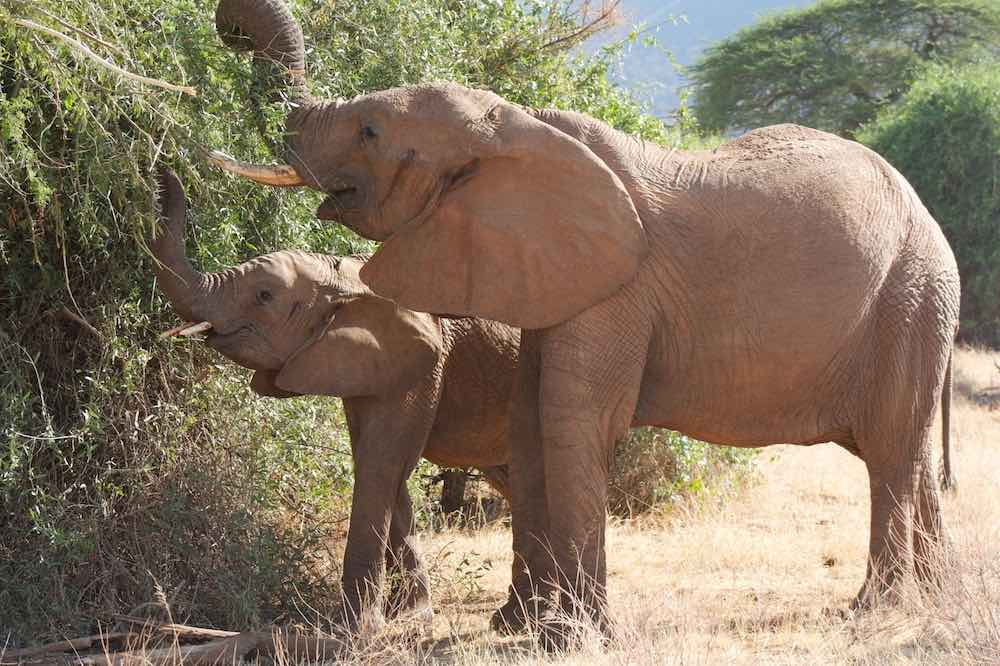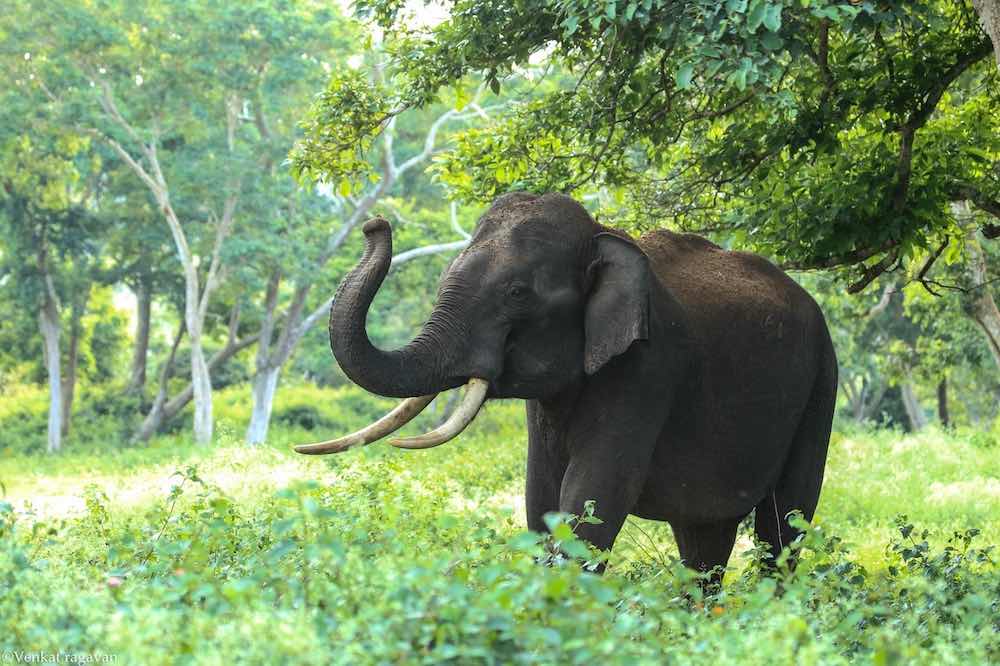Elephants being as big as they are, some will think they must have more than one stomach. But they don’t!
The elephant’s original stomach is instead subdivided into four different compartments: the rumen, reticulum, omasum, and abomasum. Each of which plays a crucial role in the digestion of the elephant’s plant-based diet.
Elephants are big animals with large appetites to match. They take up a lot of space, and they require a lot of food to keep going.
In this article, we will explore the anatomy of the “inner-elephant” go through it’s complex digestive system.
Anatomy Of The Elephant
The elephant is often known as a herbivore since it is native to both Asia and Africa.
There are three (3) species of elephants alive today: two African elephants which are the African forest elephant and the African bush elephant, as well as one Asian species (the Asian elephants).
Recommended reading: What are the differences between African- and Asian Elephants?
Elephants are among the planet’s largest land animals. All three species are on the brink of extinction. Because of their enormous size and disposition, elephants require a lot of food.
In fact, an elephant can eat more than 400 pounds of food in a day that’s because it possess multiple stomach compartments!
This is due to their large size and high metabolism. Their anatomy includes a long, flexible trunk that they use to pick up objects and smell.
They have large ears, thick skin, and a heavy, thick skeleton. The elephant’s skin contains thin layers of tissue covered by a layer of fat.
How Many Stomachs Does An Elephant Have?
Elephants have just one stomach. However, it has multiple stomach chambers.
This is because the elephant’s food is very fibrous and hard to digest. It is easier for the animal to break it down into separate compartments.
This makes elephants digest food easier and quicker. The digestion process will take from 36 to 48 hours in an elephant’s stomach primarily functions well.

Features of an Elephant’s Stomach
The first compartment (rumen)
The first compartment of the elephant’s stomach is the rumen. The rumen is like a giant sieve, trapping all of the debris and large pieces of leaves, bushes, and bark that the elephant swallows.
It is extremely helpful because it allows the elephant to graze, picking up as much food as he can at one time. The material in the rumen is very hard to digest. So it sits there for around 3 hours before being regurgitated back up.
The second compartment (reticulum)
The second compartment of the elephant’s stomach is the reticulum. The reticulum is a very small pouch that squeezes the food together to form a ball.
The third compartment (omasum)
The third compartment of the elephant’s stomach is the omasum. The omasum is a very thin membrane that is full of blood vessels.
The blood vessels help break down the food.
The fourth compartment (abomasum)
The fourth compartment of the elephant’s stomach is the abomasum. The abomasum is like a human stomach, where the digestion is completed and the nutrients are absorbed into the bloodstream.
Elephant’s Digestion Process
The large intake of food is not the only thing that makes digestion different in elephants. Their digestive system is also significantly slower than humans and other animals.
The digestive process begins from the elephant’s mouth (they have a relatively small mouth). Then, the elephant’s food will stay in the rumen (first stomach compartment) for up to 24 hours.
This is because of the large amount of fibrous material in the food that causes it to swell up and become very full.
As soon as the food leaves the rumen, it is broken into small particles in the reticulum (second stomach compartment) and then travels to the omasum (third stomach compartment), where it is mixed with digestive juices and more saliva for further breakdown.
The food then gets absorbed through the wall of the omasum and flows into the abomasum (fourth stomach compartment), where it is mixed with enzymes and acids, and finally travels to the intestines for complete digestion.
The digestion process will take from 36 to 48 hours.
Importance of an Elephant’s Stomach
The elephant’s stomach is important because it breaks down the food into smaller pieces and sends them through the rest of the digestive tract.
Food goes into the stomach, which mixes up with acid and enzymes, and breaks down into smaller pieces. Then it goes into the small intestine, where the blood absorbs nutrients.

If an elephant’s stomach was not so large and helpful and the small and large intestines were not so functional, it would take a lot longer for the elephant to digest its food.
This would mean that it would have to eat much less frequently, as well as make sure that it got every bit of nutrition out of the food that it ate.
In addition, if an elephant’s stomach was smaller, then it could not eat such large amounts of food at once.
This would mean that the elephant would need to eat more often to make up for the smaller amount of food it could eat at one time.
Diet Of The Elephants
Because of their large size and the fact that they are grazing animals, elephants eat a large amount of food each day. In fact, a study says that elephants’ daily feed requirement is as much as 28 times the daily feed intake of a cow!
Elephants eat mostly grass, bamboo, leaves, and bark. The baby elephants eat the same. When eating, they use their trunk to pick up food and put it into their mouth.
Because of the way they eat, they often swallow the leaves and grass whole. This means that the food is very difficult to digest, so it needs to travel through the elephant’s long digestive tract. This is also one of the key reasons elephants need to drink an almost ungraspable amount of water daily.
Because they eat a lot of fibrous food, it takes a long time for the food to travel through the elephant’s digestive system. This is because the food is broken down very slowly in the stomach with digestive juices.
To Conclude
The stomach of the elephant is an incredibly fascinating and complex organ that has evolved to support the unique digestive needs of these magnificent animals.
The elephant’s stomach is divided into four distinct compartments: the rumen, reticulum, omasum, and abomasum, each of which plays a crucial role in the digestion of the elephant’s plant-based diet.
The elephant’s incredible digestive system is made possible by the presence of symbiotic bacteria. These microscopic organisms help break down cellulose, a complex carbohydrate found in plants that otherwise would be difficult for the elephant to process. Without them, it would not be able to extract crucial nutrition from its meals and consequently face an uncertain future.
The elephant’s stomach is also incredibly large, with a capacity of up to 200 liters. This allows the animal to consume massive quantities of food at once, which is important for its survival in the wild.
Ultimately, the elephant’s digestive system is a remarkable reminder of how animals have adapted to their surroundings. By exploring and studying the inner workings of different creatures, we can gain valuable insight into nature – thereby paving the way for more collaborative and sustainable relationships with our planet.
Frequently Asked Questions
Contrary to popular belief, Elephants only have one stomach. It is however broken up into four compartments.
They are named rumen, reticulum, omasum, and abomasum.
An Elephant can eat up to 400 pounds (~180 kgs) in a single day.
An Elephant’s digestion process will take from 36 to 48 hours depending on the type of food it has consumed.
The elephant’s digestive system is made possible by the presence of symbiotic bacteria. These microscopic organisms help break down cellulose, a complex carbohydrate found in plants that otherwise would be difficult for the elephant to process.

2 replies on “How Many Stomachs Does An Elephant Have?”
I’m very much impressed by lover’s of Nature ,@onelove
Elephants are monogastric hindgut-fermenters, not ruminants